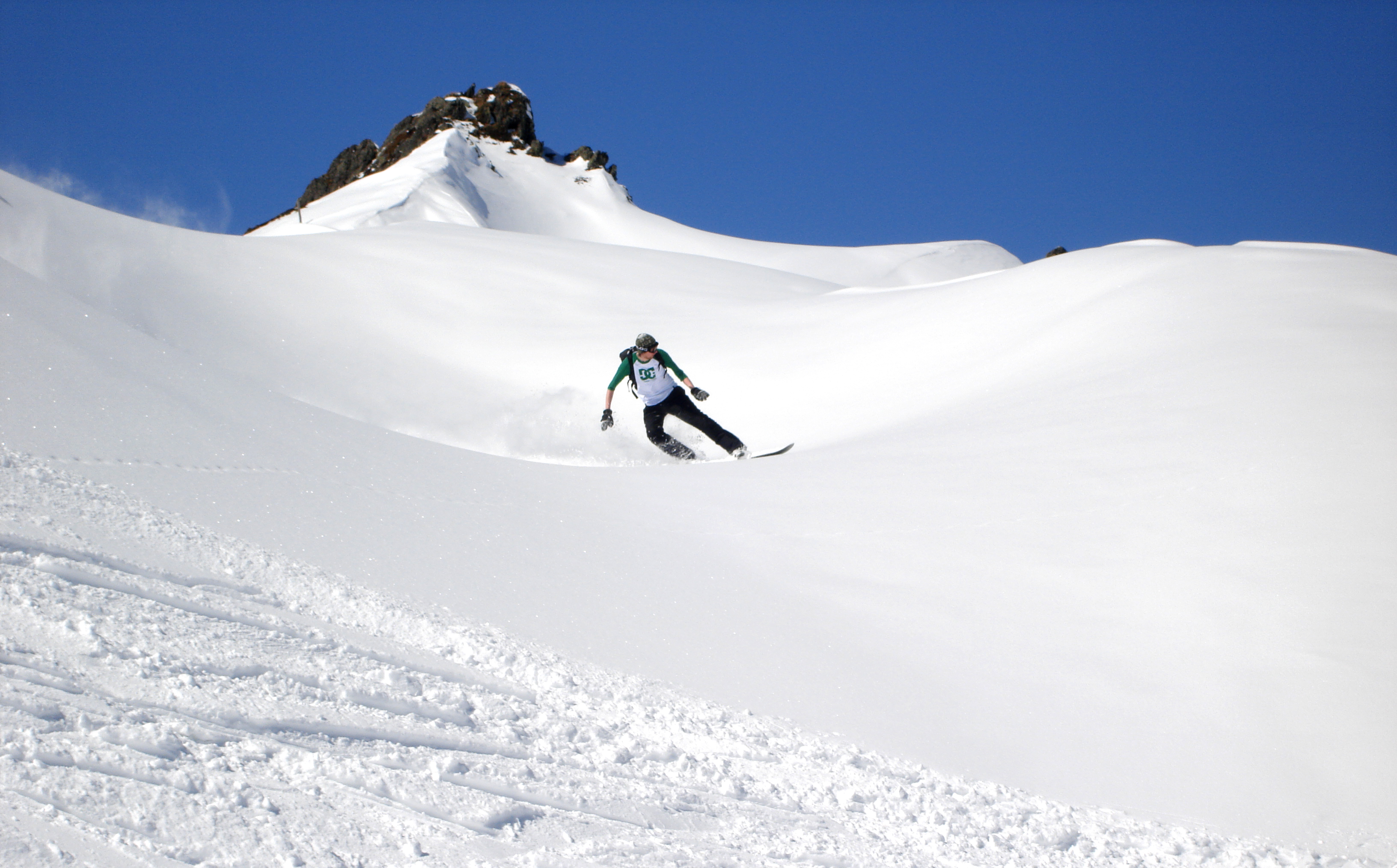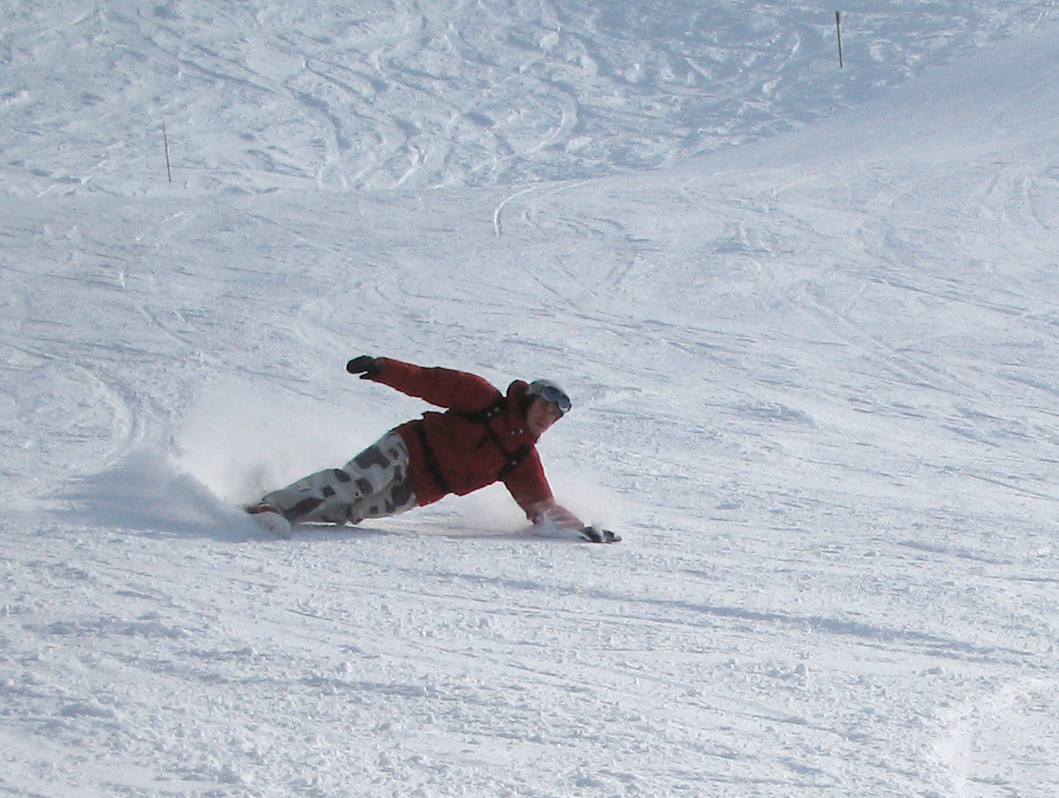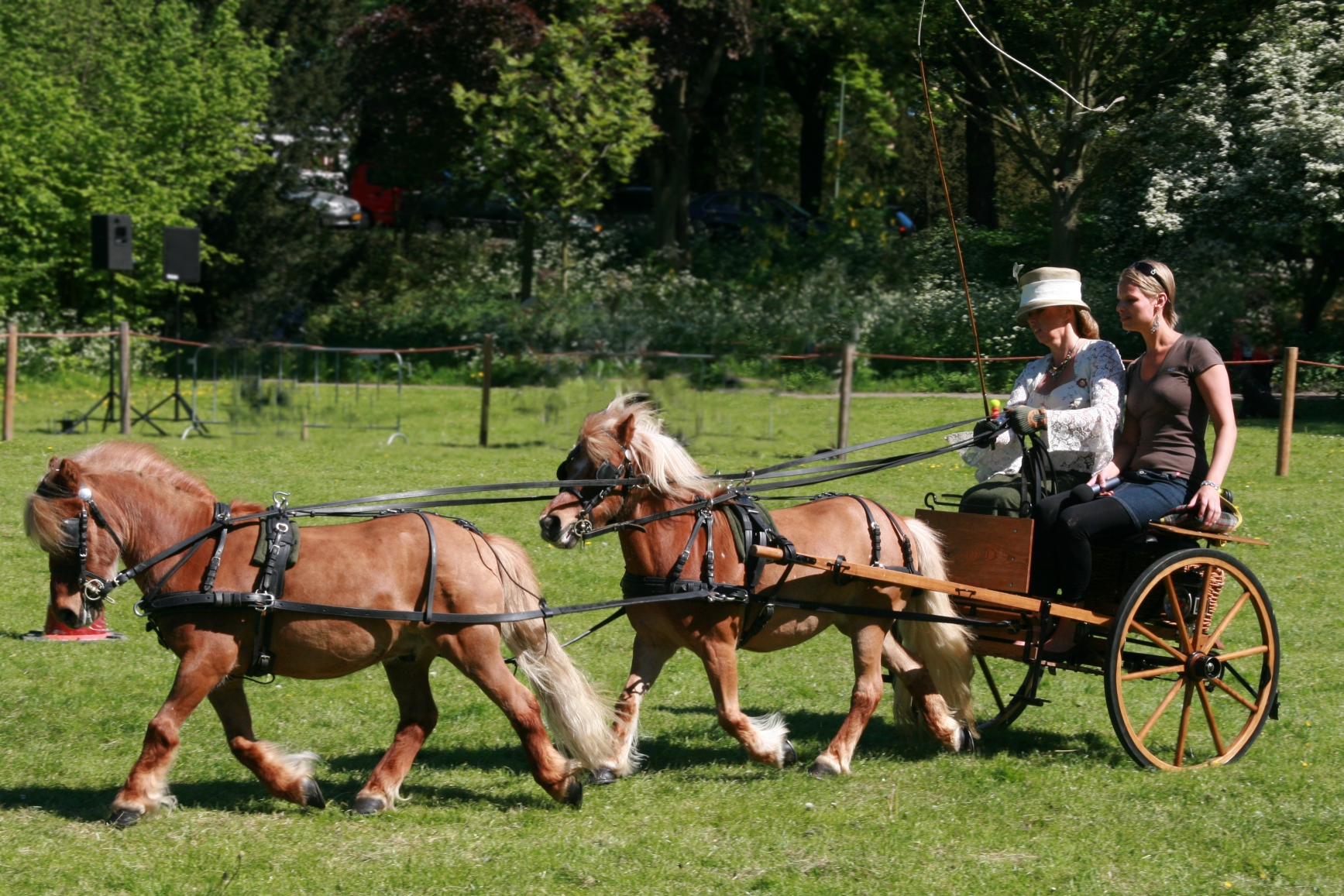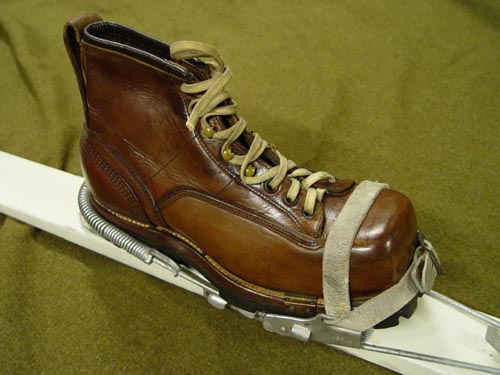|
Monoskiing
A monoski is a single wide ski used for skiing on snow. The same boots, bindings, and poles are used as in alpine skiing. Unlike in snowboarding, both feet face forward, rather than sideways to the direction of travel. Similar equipment includes the skwal and the teleboard, with feet in tandem formation (one ahead of the other). Monoskiing was invented in the late 1950s by Dennis Phillips at Hyak, Washington using a single water ski and bear trap bindings. Surfer Mike Doyle promoted the monoski in the early 1970s, after which monoskiing's relative popularity slowly increased, but the interest eventually waned in favor of snowboarding. Recently the popularity of monoskiing has increased, particularly in France and in the United States largely due to technological advances in the design of the ski. As with alpine skis the carved shape of the ski has meant easier turns, and as a result, skiers and even snowboarders are finding the transition to monoskis less daunting. Festiva ... [...More Info...] [...Related Items...] OR: [Wikipedia] [Google] [Baidu] |
Teleboard
Developed during the winter of 1996 by Martin and Erik Fey, the Teleboard consists of a long, narrow snowboard, or wide ski, with two free-heel telemark bindings arranged one in front of the other at a slight angle to the longitudinal axis. This is similar to a skwal which uses fixed-heel bindings mounted in line with each other. History When experimenting with successively narrower alpine snowboards to allow for quicker turns, the Fey brothers ended up with a board that could not fit hard-plate snowboard bindings, and tried telemark bindings instead. After a successful trial down a mogul run at Killington (one of the only remaining open trails in New England at the end of that ski season), they continued to refine the design. The Teleboard earned them two patents between 1997 and 1999. The Fey Bros went on to found Telemarkdown.com and continue to sell Teleboards as well as Telemark and AT ski gear in their two New England shops. Physical characteristics The unique binding alig ... [...More Info...] [...Related Items...] OR: [Wikipedia] [Google] [Baidu] |
Monoski
A monoski is a single wide ski used for skiing on snow. The same boots, bindings, and poles are used as in alpine skiing. Unlike in snowboarding, both feet face forward, rather than sideways to the direction of travel. Similar equipment includes the skwal and the teleboard, with feet in tandem formation (one ahead of the other). Monoskiing was invented in the late 1950s by Dennis Phillips at Hyak, Washington using a single water ski and bear trap bindings. Surfer Mike Doyle promoted the monoski in the early 1970s, after which monoskiing's relative popularity slowly increased, but the interest eventually waned in favor of snowboarding. Recently the popularity of monoskiing has increased, particularly in France and in the United States largely due to technological advances in the design of the ski. As with alpine skis the carved shape of the ski has meant easier turns, and as a result, skiers and even snowboarders are finding the transition to monoskis less daunting. Festiva ... [...More Info...] [...Related Items...] OR: [Wikipedia] [Google] [Baidu] |
Skiing
Skiing is the use of skis to glide on snow. Variations of purpose include basic transport, a recreational activity, or a competitive winter sport. Many types of competitive skiing events are recognized by the International Olympic Committee (IOC), and the International Ski Federation (FIS). History Skiing has a history of almost five millennia. Although modern skiing has evolved from beginnings in Scandinavia, it may have been practiced more than 100 centuries ago in what is now China, according to an interpretation of ancient paintings. However, this continues to be debated. The word "ski" comes from the Old Norse word "skíð" which means to "split piece of wood or firewood". Asymmetrical skis were used in northern Finland and Sweden until at least the late 19th century. On one foot, the skier wore a long straight non-arching ski for sliding, and a shorter ski was worn on the other foot for kicking. The underside of the short ski was either plain or covered with animal ... [...More Info...] [...Related Items...] OR: [Wikipedia] [Google] [Baidu] |
Ski Boot
Ski boots are footwear used in skiing to provide a way to attach the skier to skis using ski bindings. The ski/boot/binding combination is used to effectively transmit control inputs from the skier's legs to the snow. History Ski boots were leather winter boots, held to the ski with leather straps. As skiing became more specialized, so too did ski boots, leading to the splitting of designs between those for alpine skiing and cross-country skiing (sport), cross-country skiing. Modern skiing developed as an all-round sport with uphill, downhill and cross-country portions. The introduction of the cable binding started a parallel evolution of binding and boot. The binding looped a strap around the back of the boot to hold it forward into a metal cup at the toe. Boots with the sole extended rearward to produce a flange for the cable to firmly latch to become common, as did designs with semi-circular indentations on the heel for the same purpose. Effective cross-country skiing requires ... [...More Info...] [...Related Items...] OR: [Wikipedia] [Google] [Baidu] |
Ski Bindings
A ski binding is a device that connects a ski boot to the ski. Before the 1933 invention of ski lifts, skiers went uphill and down and cross-country on the same gear. As ski lifts became more prevalent, skis—and their bindings—became increasingly specialized, differentiated between alpine (downhill) and Nordic ( cross-country, Telemark, and ski jumping) styles of skiing. Until the point of divergence in the mid-20th century, bindings held the toe of a flexible, leather boot against the ski and allowed the heel to rise off the ski, typically with a form of strap or cable around the heel. To address injuries resulting from falls while skiing downhill on such equipment, ski bindings emerged with the ability to release the toe of the boot sideways, in early models, and to release the boot forward and aft, in later models. Downhill ski bindings became standardized to fit plastic ski boots and incorporated a built-in brake that drags in the snow after the ski detaches from the boot. ... [...More Info...] [...Related Items...] OR: [Wikipedia] [Google] [Baidu] |
Ski Poles
Ski poles, also referred to as poles (in North America), sticks (UK), or stocks (Australia), are used by skiers for balance and propulsion. Modern ski poles are most commonly made from aluminum and carbon fiber, though materials such as bamboo are still used. Poles are used in alpine skiing, freestyle skiing (with the exception of aerials), and cross-country skiing. Ski jumpers do not use poles. History , the earliest ski pole was found in Sweden and dates back to 3623 BC, while the earliest depiction of a man with a ski pole was found in Norway in the form of a cave painting, dated at 4000 BC. Early skiers would use this pole for the purposes of balancing, braking, and turning. Alpine societies such as those in Nordic regions or the Altai mountains used their ski poles to hunt as well, giving them spear-like qualities. Skiers began to use two ski poles in 1741. This provided greater balance than one pole could provide and made pushing through the snow easier. Early ski po ... [...More Info...] [...Related Items...] OR: [Wikipedia] [Google] [Baidu] |
Alpine Skiing
Alpine skiing, or downhill skiing, is the pastime of sliding down snow-covered slopes on skis with fixed-heel bindings, unlike other types of skiing ( cross-country, Telemark, or ski jumping), which use skis with free-heel bindings. Whether for recreation or for sport, it is typically practiced at ski resorts, which provide such services as ski lifts, artificial snow making, snow grooming, restaurants, and ski patrol. "Off-piste" skiers—those skiing outside ski area boundaries—may employ snowmobiles, helicopters or snowcats to deliver them to the top of a slope. Back-country skiers may use specialized equipment with a free-heel mode, including 'sticky' skins on the bottoms of the skis to stop them sliding backwards during an ascent, then locking the heel and removing the skins for their descent. Alpine skiing has been an event at the Winter Olympic Games since 1936. A competition corresponding to modern slalom was introduced in Oslo in 1886. Participants and venues ... [...More Info...] [...Related Items...] OR: [Wikipedia] [Google] [Baidu] |
Snowboarding
Snowboarding is a recreational and competitive activity that involves descending a snow-covered surface while standing on a snowboard that is almost always attached to a rider's feet. It features in the Winter Olympic Games and Winter Paralympic Games. Snowboarding was developed in the United States, inspired by skateboarding, sledding, surfing, and skiing. It became popular around the globe, and was introduced as a Winter Olympic Sport at Nagano in 1998 and featured in the Winter Paralympics at Sochi in 2014. , its popularity (as measured by equipment sales) in the United States peaked in 2007 and has been in a decline since. History The first snowboards were developed in 1965 when Sherman Poppen, an engineer in Muskegon, Michigan, invented a toy for his daughters by fastening two skis together and attaching a rope to one end so he would have some control as they stood on the board and glided downhill. Dubbed the "snurfer" (combining snow and surfer) by his wife Nancy, ... [...More Info...] [...Related Items...] OR: [Wikipedia] [Google] [Baidu] |
Skwal
A skwal is the main piece of equipment used for skwalling, a hybrid sport combining the carving of skiing and riding feel of snowboarding. It is similar to a snowboard or monoski in that both feet are attached to the same board. On a skwal the feet are one in front of the other, in line with the direction the skwal is pointing in. This differs from snowboards (in which the feet are side-on to the direction of the board) and monoskis (in which the feet point in the direction of the board, but are side-by-side). History The skwal was invented by two French ski-school instructors Patrick "Thias" Balmain and Manuel Jammes, with the first prototype appearing in 1992. They envisaged it as a way to offer different sensations to what skiing and snowboarding could offer, at a time when 'carving' skis were only just starting to take off. A French company called Lacroix took an interest, recruited Patrick Balmain, and started producing skwals. A few years later, Patrick left Lacroix a ... [...More Info...] [...Related Items...] OR: [Wikipedia] [Google] [Baidu] |
Tandem
Tandem, or in tandem, is an arrangement in which a team of machines, animals or people are lined up one behind another, all facing in the same direction. The original use of the term in English was in ''tandem harness'', which is used for two or more draft horses, or other draft animals, harnessed in a single line one behind another, as opposed to a pair, harnessed side by side, or a team of several pairs. The tandem harness allows additional animals to provide pulling power for a vehicle designed for a single animal. The English word ''tandem'' derives from the Latin adverb , meaning ''at length'' or ''finally''. It is a word play, using the Latin phrase (referring to time, not position) for English "at length, lengthwise". Tandem bicycles are named for their tandem seating, a more common arrangement than side-by-side "sociable" seating. ''Tandem'' can also be used more generally to refer to any group of persons or objects working together, not necessarily in line. Automob ... [...More Info...] [...Related Items...] OR: [Wikipedia] [Google] [Baidu] |
Hyak, Washington
Hyak is an unincorporated community located on Snoqualmie Pass in Kittitas County, Washington. It is located within the Snoqualmie Pass CDP. Hyak was established around 1915 at the eastern portal of the Snoqualmie Pass Milwaukee Road Railroad tunnel. Originally a train station, the community began to grow in the 1930s when the railroad built a world class ski area. Today there are approximately 200 full-time residences in Hyak and another 100 part-time. Hyak is a Chinook Jargon word meaning "hurry", "fast", or "swift". Geography Hyak is located east of the summit of Snoqulamie Pass at an elevation of . It is northwest of Easton and is part of the Easton school district. History In 1915, Hyak replaced Laconia as the main train station on Snoqualmie Pass. Hyak had a small school house, and a post office. The Milwaukee road built a ski area at Hyak (from 1937–1950) originally known as The Snoqualmie Ski Bowl until World War II. [...More Info...] [...Related Items...] OR: [Wikipedia] [Google] [Baidu] |
Cable Binding
Cable bindings, also known as Kandahar bindings or bear-trap bindings, are a type of ski bindings widely used through the middle of the 20th century. It was invented and brand-named after the Kandahar Ski Club in 1929 by ski racer and engineer Guido Reuge. They were replaced in alpine skiing by heel-and-toe "safety bindings" in the mid-1960s. The cable binding attaches firmly at the toe only, normally in a trapezoidal metal cup roughly the same as the toe of a boot. A strap is fastened over the toe to stop it from rising out of the cup vertically.Lert, p. 25 Another cable holds the boot forward into the cup, and under the toe strap. If the heel is lifted, causing the boot to rotate in the toe clip, a spring keeps tension on the cable to keep the boot pressed forward. The Kandahar version added two small metal clips on either side of the boot, normally near the instep or heel. For cross-country skiing the cable was left on top of the clips, allowing the heel to move vertically. Fo ... [...More Info...] [...Related Items...] OR: [Wikipedia] [Google] [Baidu] |







